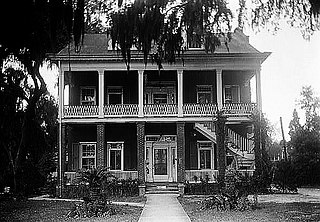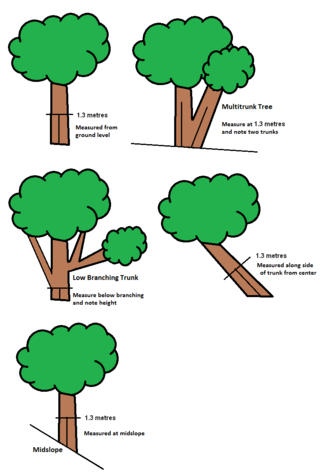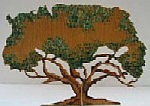
Quercus ilex, the evergreen oak, holly oak or holm oak is a large evergreen oak native to the Mediterranean region. It is a member of the Ilex section of the genus, with acorns that mature in a single summer.

Quercus virginiana, also known as the southern live oak, is an evergreen oak tree endemic to the Southeastern United States. Though many other species are loosely called live oak, the southern live oak is particularly iconic of the Old South. Many very large and old specimens of live oak can be found today in the Deep South region of the United States.

Live oak or evergreen oak is any of a number of oaks in several different sections of the genus Quercus that share the characteristic of evergreen foliage. These oaks are generally not more closely related to each other than they are to other oaks.

Quercus laevis, the turkey oak, is a member of the red oak group of oaks. It is native to the southeastern United States. The name turkey oak derives from the resemblance of the leaves to a turkey's foot. A Turkish and southern European species Quercus cerris is also commonly referred to as Turkey oak, so Quercus laevis is sometimes referred to as American turkey oak to distinguish it from the European species.

Quercus fusiformis, commonly known as escarpment live oak, plateau live oak, plateau oak, or Texas live oak, is an evergreen or nearly evergreen tree. Its native range includes the Quartz Mountains and Wichita Mountains in southwestern Oklahoma, through Texas, to the Mexican states of Coahuila, Tamaulipas, and Nuevo León.

Quercus phellos, the willow oak, is a North American species of a deciduous tree in the red oak group of oaks. It is native to the south-central and eastern United States.

The "Big Tree", near the town of Rockport, Texas, is one of the most famous live oaks in the world after being named "Texas State Champion Virginia Live Oak" in 1969. The tree retained that title until 2003, when a larger oak was discovered in Brazoria County, Texas. The "Big Tree" is still thought to be one of the largest live oak specimens in the United States.

Airlie Gardens is a 67-acre (27 ha) public garden in Wilmington, North Carolina.

Florida sand pine scrub is an endangered subtropical forest ecoregion found throughout Florida in the United States. It is found on coastal and inland sand ridges and is characterized by an evergreen xeromorphic plant community dominated by shrubs and dwarf oaks. Because the low-nutrient sandy soils do not retain moisture, the ecosystem is effectively an arid one. Wildfires infrequently occur in the Florida scrub. Most of the annual rainfall falls in summer. It is endangered by residential, commercial and agricultural development, with the largest remaining block in and around the Ocala National Forest. Lake Wales Ridge National Wildlife Refuge also holds a high proportion of remaining scrub habitat, while the Archbold Biological Station near Lake Placid contains about 20 km2 (7.7 sq mi) of scrub habitat and sponsors biological research on it.

Seven Sisters Oak, located in Mandeville, Louisiana, is a notably large southern live oak in Louisiana. The tree was originally registered at the Live Oak Society as "Doby’s Seven Sisters" because the Doby family owned the property where the tree was located and Mrs. Doby was one of seven sisters. The tree was renamed "Seven Sisters Oak" and reregistered at the Live Oak Society as member number 697. Seven Sisters Oak is the current president of the Live Oak Society, a status awarded to it by being the largest live oak registered by the society. Although there was some controversy as to whether the oak was one tree or several trees that had grown together, an inspection by professional foresters in 1976 determined that the tree developed from a single root system.

Quercus austrina, the bastard white oak or bluff oak, is an oak species that is endemic to the southeastern United States from Mississippi to the Carolinas, with a few isolated populations in Arkansas.

Quercus arkansana, the Arkansas oak, is a species of oak tree. It is native to the southeastern United States. It is threatened by use of its habitat for pine plantations, clearing of land, and diebacks that may be caused by drought.

Tullis-Toledano Manor, also known as, the Toledano-Philbrick-Tullis House, was a red-clay brick mansion on the Mississippi Gulf Coast in Biloxi. It was considered an example of Greek Revival architecture. The mansion was added to the National Register of Historic Places in 1976 and was destroyed by Hurricane Katrina in 2005.

The Big Oak is a large live oak located in Thomasville, Georgia, in the United States at the corner of Crawford Street and Monroe Street. The Big Oak is one of many historic landmarks located in Thomasville. The Big Oak was one of the earliest trees registered with the Live Oak Society. Registered by P.C. Andrews in 1936, the Big Oak was the forty-ninth live oak registered. At the time of registration, the Big Oak's girth was 21 feet 6 inches.

Quercus geminata, commonly called sand live oak, is an evergreen oak tree native to the coastal regions of the subtropical southeastern United States, along the Atlantic Coast from southern Florida northward to southeastern Virginia and along the Gulf Coast westward to southern Mississippi, on seacoast dunes and on white sands in evergreen oak scrubs.

Friendship Oak is a 500-year-old southern live oak located on the Gulf Park campus of the University of Southern Mississippi in Long Beach, Mississippi. The campus was formerly Gulf Park College for Women from 1921 until 1971.

Tree girth measurement is one of the most ancient, quickest, and simplest of foresters' measures of size and records of growth of living and standing trees. The methods and equipment have been standardized differently in different countries. A popular use of this measurement is to compare outstanding individual trees from different locations or of different species.
Trees have a wide variety of sizes and shapes and growth habits. Specimens may grow as individual trunks, multitrunk masses, coppices, clonal colonies, or even more exotic tree complexes. Most champion tree programs focus finding and measuring the largest single-trunk example of each species. There are three basic parameters commonly measured to characterize the size of a single trunk tree: tree height measurement, tree girth measurement, and tree crown measurement. Foresters also perform tree volume measurements. A detailed guideline to these basic measurements is provided in The Tree Measuring Guidelines of the Eastern Native Tree Society by Will Blozan.

The Newland Oak was a veteran oak tree in Newland, Gloucestershire in England. Originally part of the ancient woodland of the Forest of Dean, it survived clearances that created the settlement of Newland and was afterwards pollarded for timber. Its large size was often remarked upon through the years and it was considered a rival to the Cowthorpe Oak as the largest oak tree in Great Britain. Much of the tree fell during heavy snow in 1955 but a single branch of the tree survived until 1970 when it was killed during an arson attack. A replacement tree grown from one of the Newland Oak's acorns had been planted in 1964.

The Marton Oak is a large, ancient sessile oak which grows in the village of Marton, Cheshire. The tree has a girth of 14.02 metres (46.0 ft) measured at 1.5 metres off the ground, making it the UK's largest and widest tree since the collapse of the Newland Oak in Gloucestershire, surpassing trees such as the Bowthorpe Oak in Lincolnshire and the three large sweet chestnut trees at Canford School, Dorset. The tree is believed to be 1,200 years old, and is thought to be in the latter stages of its lifespan, as most of the heartwood has rotted away. The tree split into sections centuries ago, but they have one and the same root system. It is not known what the tree looked like before it split.





















